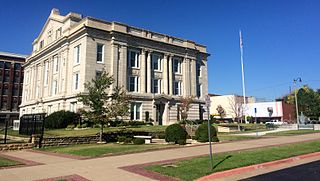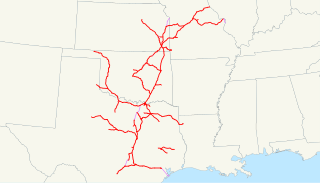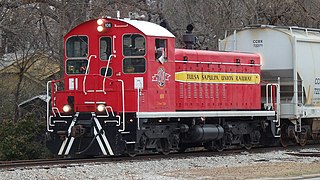Related Research Articles

Sapulpa is a city in Creek and Tulsa counties in the U.S. state of Oklahoma. The population was 21,929 at the time of the 2020 census, compared with 20,544 at the 2010 census. It is the county seat of Creek County.

Okmulgee is a city in and the county seat of Okmulgee County, Oklahoma, United States, and is part of the Tulsa Metropolitan Area. The name is from the Muskogee word okimulgee, which means "boiling waters". The site was chosen because of the nearby rivers and springs. Okmulgee is 38 miles south of Tulsa and 13 miles north of Henryetta via US-75.

Sinclair Oil Corporation was an American petroleum corporation founded by Harry F. Sinclair on May 1, 1916. The Sinclair Oil and Refining Corporation amalgamated the assets of 11 small petroleum companies. Originally a New York corporation, Sinclair Oil reincorporated in Wyoming in 1976. The corporate logo featured the silhouette of a large green Brontosaurus dinosaur, based on the then-common idea that oil deposits beneath the earth came from the dead bodies of dinosaurs.

The Missouri–Kansas–Texas Railroad was a Class I railroad company in the United States, with its last headquarters in Dallas, Texas. Established in 1865 under the name Union Pacific Railroad (UP), Southern Branch, it came to serve an extensive rail network in Texas, Oklahoma, Kansas, and Missouri. In 1988, it merged with the Missouri Pacific Railroad; today, it is part of UP.

The St. Louis–San Francisco Railway, commonly known as the "Frisco", was a railroad that operated in the Midwest and South Central United States from 1876 to November 21, 1980. At the end of 1970, it operated 4,547 miles (7,318 km) of road on 6,574 miles (10,580 km) of track, not including subsidiaries Quanah, Acme and Pacific Railway and the Alabama, Tennessee and Northern Railroad; that year, it reported 12,795 million ton-miles of revenue freight and no passengers. In 1980 it was purchased by and absorbed into the Burlington Northern Railroad. Despite its name, it never came close to San Francisco.
West Tulsa is a local name given to an area situated in the west section of the city of Tulsa, Oklahoma which includes various communities to the west and south of the Arkansas River. As development between Sand Springs and Tulsa continued in the late 19th through the early 20th centuries, the name West Tulsa was used to refer to this area west of Tulsa and north of the Arkansas River, but many people in Tulsa and those knowing of the history of Tulsa do not include this area near Sand Springs when referring to West Tulsa.
The title of "Oil Capital of the World" is often used to refer to Tulsa, Oklahoma. Houston, Texas, the current center of the oil industry, more frequently uses the sobriquet “The Energy Capital of the World.”
Tulsa is the second-largest city in the state of Oklahoma and 45th-most populous city in the United States.

Oklahoma City Union Depot is a building in Oklahoma City, Oklahoma that served as a "union station" from 1931 until 1967. It was listed on the National Register of Historic Places in 1979. It now houses the offices of the Scissortail Park Foundation.

Joseph Stephen Cullinan was a U.S. oil industrialist. Although he was a native of Pennsylvania, his lifetime business endeavors would help shape the early phase of the oil industry in Texas. He founded The Texas Company, which would eventually be known as Texaco Incorporated.

The Meteor was a named passenger train operated by the St. Louis-San Francisco Railway. It ran overnight between Oklahoma City and St. Louis via Tulsa and was later extended to Lawton, Oklahoma on July 18, 1955. The name was shared with a branch line Meteor running between Monett, Missouri, and Paris, Texas. Later this line was truncated to terminate at Fort Smith, Arkansas.
The Arkansas Valley and Western Railway (AV&W) was built as a short line railroad operating within the U.S. state of Oklahoma. It was founded in 1902 to link the city of Tulsa with the main transcontinental line of the Atchison, Topeka and Santa Fe Railway (AT&SF) at Avard. The line was built in sections, initially from AV&W Jct. to Steen (Enid) during 1902-03. In 1904 it was extended westward to the junction with AT&SF at Avard. On July 19, 1907, the railroad was purchased by the St. Louis-San Francisco Railway, who operated it until November 21, 1980, when the Frisco was acquired by Burlington Northern Railroad.
HF Sinclair Corporation is a diversified energy company that manufactures and sells products such as gasoline, diesel fuel, jet fuel, renewable diesel, specialty lubricant products, specialty chemicals, and specialty and modified asphalt, among others. It is based in Dallas, Texas, United States.

The Puget Sound Refinery is an oil refinery on March Point near Anacortes, Washington, United States. It is operated by HF Sinclair and is one of the largest employers in Skagit County. The refinery has a capacity of 145,000 barrels a day, making it the 52nd largest in the United States, in 2015, with facilities that include a delayed coker, fluid catalytic cracker, polymerization unit and alkylation units. HF Sinclair’s refinery produces three grades of gasoline, fuel oil, diesel fuel, propane and butane. This plant is currently the only refinery in Washington state unable to accommodate tight oil via rail. The permitting process is currently underway for the proposed 60,000 b/d unloading capacity of the East Gate Rail Project.

Tulsa–Sapulpa Union Railway Company, L.L.C. is a Class III shortline rail carrier which operates freight service between Tulsa, Oklahoma and Sapulpa, Oklahoma over 10 miles of track known as the Sapulpa Lead, and which also leases and operates a 12.9 mile section of Union Pacific track known as the Jenks Industrial Lead between Tulsa and Jenks, Oklahoma. The line connects with two Class I railroads, being the Union Pacific at Tulsa and the BNSF at Sapulpa, and additionally connects to its fellow Class III shortline, the Sand Springs Railway, in Tulsa. It is owned by the Collins Family Trust. Major customers on the Sapulpa Lead include Technotherm, Prescor, and Ardagh Glass, and on the Jenks Industrial Lead, the HF Sinclair oil refinery, Kentube, Word Industries, Pepsi Cola, and Kimberly-Clark.
The Miami Mineral Belt Railroad (MMBR) served the Miami and Picher lead mining areas in that portion of the Tri-state mining district located in far northeastern Oklahoma. It was closely associated with the St. Louis-San Francisco Railway (Frisco) for its entire history, and was eventually absorbed into the Frisco.
The Oklahoma City and Western Railroad, together with its affiliate the Oklahoma City and Texas Railroad, built a line from Oklahoma City through Lawton, Oklahoma and on to Quanah, Texas in the 1901-1903 timeframe. By the time of its completion, the line was owned by the St. Louis-San Francisco Railway (Frisco), and all assets were absorbed into the Frisco in 1907.
American Republics Corporation was a Texas oil company that was founded by Joseph S. Cullinan in Houston, Texas in 1916. Joseph S. Cullinan owned Farmers Oil Company and other companies. Cullinan consolidated with twenty subsidiary companies into the American Republics Corporation. American Republics Corporation became the holding company for all the subsidiary. By 1927 American Republics Corporation owned two million acres of oil land, refineries, rail tankers and tanker ships. Cullinan resigned as president of American Republics Corporation in 1928. During the Great Depression American Republics Corporation was forced into receivership. In 1936 Cullinan returned and became president again. American Republics Corporation was active in supporting the World War II efforts with oil supply and tanker ships.
The St. Louis, San Francisco and New Orleans Railroad ran from Hope, Arkansas to a point near Ardmore, Oklahoma, and encompassed about 219 miles of track including a branch line. It existed from 1895 to 1907, when its assets were taken over by the St. Louis-San Francisco Railway (“Frisco”).
References
- 1 2 3 4 5 6 7 8 9 10 11 "Valuation Docket 637, The West Tulsa Belt Railway Company". Decisions of the Interstate Commerce Commission of the United States, June-July 1932, pp. 870-879. 1933. Retrieved October 27, 2021.
- 1 2 Douglas, Clarence B. (1921). "Charles Louis Huonker" . Retrieved October 27, 2021.
- 1 2 "Cullinan, Joseph Stephen". Tommy W. Stringer, Texas State Historical Association. Retrieved October 27, 2021.
- 1 2 "Old West Tulsa Alluring". Anna F. Brown, SouthwestTulsa.org, December 18, 2001. Retrieved October 27, 2021.
- ↑ "In the Matter of the Application of the St. Louis-San Francisco Railway Company". Sixteenth Annual Report of the Corporation Commission of the State of Oklahoma for year ending June 30, 1923, p.210. 1923. Retrieved October 26, 2021.
- ↑ "Sinclair buys Texaco refinery". UPI, July 29, 1983. Retrieved October 27, 2021.
- ↑ "Tulsa Refinery". HF Sinclair. Retrieved August 21, 2022.